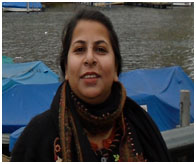Focal Person of SDG-14
Dr. Maria Hussain
Associate Professor,
Department of Mathematics,
LCWU, Lahore
Description of SDG 14: LIFE BELOW WATER
“CONSERVE AND SUSTAINABLY USE THE OCEANS, SEA AND MARINE RESOURCES FOR SUSTAINABLE DEVBELOPMENT”
Oceans, seas and coastal areas are almost two-thirds of the earth surface. These are influencing earth climate, human health, biodiversity, and a great source of work-generation and food generation. Oceans are the regulator of global earth climate and are used as a sink for greenhouse gases. These are the huge source of water (97%) and provides us the oxygen to breathe. However, the OCEAN LIFE is under severe threat. The DEAD ZONES in oceans are increasing day by day. In 2008, there were about 400 dead zones worldwide. According to the statistics of 2019 the number has increased to 700. Major threats for LIFE BELOW WATER are the following:
(i) Plastic Thrown on Beaches
(ii) Marine Pollution (thrash or chemical discharge of industries)
(iii) Fishery Collapse (over or under fishery)
(iv) Ocean Warming
(v) Acidification
(vi) Eutrophication
All this is alarming because about three billion people’s livelihood is dependent on ocean. Keeping in view the UN in 2015 included it as SDG and fixed the following goals/targets [1]:
(i) By 2025, prevent and significantly reduce marine pollution of all kinds, in particular from land-based activities, including marine debris and nutrient pollution [1].
(ii) By 2020, sustainably manage and protect marine and coastal ecosystems to avoid significant adverse impacts, including by strengthening their resilience, and take action for their restoration in order to achieve healthy and productive oceans [1]
(iii) Minimize and address the impacts of ocean acidification, including through enhanced scientific cooperation at all levels [1]
(iv) By 2020, effectively regulate harvesting and end overfishing, illegal, unreported and unregulated fishing and destructive fishing practices and implement science-based management plans, in order to restore fish stocks in the shortest time feasible, at least to levels that can produce maximum sustainable yield as determined by their biological characteristics [1]
(v) By 2020, conserve at least 10 per cent of coastal and marine areas, consistent with national and international law and based on the best available scientific information [1]
(vi) By 2020, prohibit certain forms of fisheries subsidies which contribute to overcapacity and overfishing, eliminate subsidies that contribute to illegal, unreported and unregulated fishing and refrain from introducing new such subsidies, recognizing that appropriate and effective special and differential treatment for developing and least developed countries should be an integral part of the World Trade Organization fisheries subsidies negotiation [1]
(vii) By 2030, increase the economic benefits to Small Island developing States and least developed countries from the sustainable use of marine resources, including through sustainable management of fisheries, aquaculture and tourism [1]
(viii) Increase scientific knowledge, develop research capacity and transfer marine technology, taking into account the Intergovernmental Oceanographic Commission Criteria and Guidelines on the Transfer of Marine Technology, in order to improve ocean health and to enhance the contribution of marine biodiversity to the development of developing countries, in particular small island developing States and least developed countries [1]
(ix) Provide access for small-scale artisanal fishers to marine resources and markets [1]
(x) Enhance the conservation and sustainable use of oceans and their resources by implementing international law as reflected in UNCLOS, which provides the legal framework for the conservation and sustainable use of oceans and their resources, as recalled in paragraph 158 of The Future We Want [1]
Reference
[1] Sustainable Development Goals | United Nations Development Programme (undp.org)

